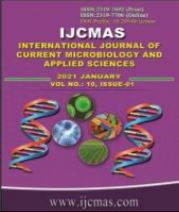


 National Academy of Agricultural Sciences (NAAS)
National Academy of Agricultural Sciences (NAAS)

|
PRINT ISSN : 2319-7692
Online ISSN : 2319-7706 Issues : 12 per year Publisher : Excellent Publishers Email : editorijcmas@gmail.com / submit@ijcmas.com Editor-in-chief: Dr.M.Prakash Index Copernicus ICV 2018: 95.39 NAAS RATING 2020: 5.38 |
Maize crop requires number of macro-nutrients and micro-nutrients for its growth and development. Nitrogen is one of the key nutrients needed for crop production; however, it is the most mobile and volatile and mainly exhausted nutrients due to its ability to exist in unusual forms and its easy leach ability. Lack of knowledge among the maize growers about the consequences of irrational use of water and nitrogen is mainly responsible for low water use efficiency and nitrogen use efficiency at field level. A field experiment was conducted during kharif, 2018 and rabi, 2019 under maize crop at the field irrigation laboratory, Department of Soil and Water Engineering, Dr. N. T. R. College of Agricultural Engineering, Bapatla, Guntur district of Andhra Pradesh State, India. The rainfall received during crop growing period of kharif 2018 was 303.4 mm and 69.1 mm during rabi, 2018-19. The initial soil physical and chemical properties of the experiment site were calculated. The inline drip irrigation system was designed in split pot for the experiment with three irrigation levels (main plots) namely I1= 0.6 of the crop evapotranspiration, I2= 0.8 of the crop evapotranspiration and I3=1.0 of the crop evapotranspiration and four nitrogen levels ( sub plots) namely N1= Drip fertigation with 80% of recommended dose of nitrogen (CF), N2= Drip fertigation with 100% of recommended dose of nitrogen (CF), N3= Drip fertigation with 120% of recommended dose of nitrogen (CF) and N4= No drip fertigation (manual application) with 100% of recommended dose of nitrogen (CF) with three replications. The amount of crop water requirement of maize was estimated with computer software CROPWAT (v 8.0). The dry matter production (DMP) and nitrogen use efficiency (NUF) of maize were estimated for both the seasons. The results shown that during kharif 2018 the highest value of DMP was found in I3 treatment (399.22 kg ha-1) followed by I2 and I1 treatments (392.93 and 381.90 kg ha-1). During rabi 2018-19, the value of DMP was found in I3 treatment (574.62 kg ha-1) followed by I2 and I1 treatments (565.29 and 446.38 kg ha-1). The highest NUE of 32.88 kg ha-1 mm-1 was obtained in I2N1 treatment during kharif 2018. During rabi 2018-19, the highest NUE of 32.85 kg ha-1 mm-1 was in I2N2. The lowest NUE of 21.35 and 22.36 kg ha-1 mm-1 was obtained in I1N3 treatment during kharif 2018 and rabi 2018-19.
 |
 |
 |
 |
 |